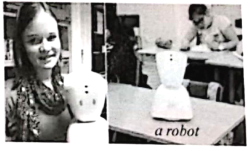-
阅读短文, 根据短文内容, 从短文后各题所给的A, B, C, D四个选项中, 选择最佳选项。

Zoe Johnson, 16, hasn't been at school for 4 years. "She went to the doctor in 2014 with a bit of a sore throat, and somehow that became very serious." says her mother, Rachel Johnson. Zoe missed a lot of school work but was able to continue with her studies with the help of an online teacher. But "over the years her real-world friendships disappeared(消失)because she's not well enough to see anybody, " says Ms Johnson.
For the last three months, though, she has been taking classes with her former classmates using a “telepresence" robot called AVI. The small, cute-looking robot, made by Oslo-based start-up No Isolation, sits in the classroom and sends live streams video and audio(直播视频和音频)back to Zoe's ipad, phone or computer at home. She can speak through the robot and take part in lessons, and also control(控制)where AVI is looking.
When she wants to ask a question, the robot's head starts blinking on and off to tell the teacher. And when she's too tired or sick to join in, she can turn AVI's head blue to ask for a leave. "It makes my life a lot more exciting and makes me feel like I haven't been forgotten," Zoe says. With the robot's help, she was able to take five GCSE exams this year. "We're celebrating because she did so much better than we ever hoped, " says Ms Johnson. "Zoe is going on to study A-level History and is looking forward to doing so with her friends, rather than on her own at home".
Karen Dolva, the 27-year-old Norwegian co-founder of No Isolation, has a friend working as a nurse in a children's hospital. "These kids are very sad and they can only see their families," her friend says. Karen and her friends at No Isolation all know about engineering and technology. They talk to the children and find out that phones and messaging apps such as Facebook are not enough to address(表达)their feelings of isolation(隔绝). “We get to know the kids need to be present somewhere they aren't, " says Karen.
But the children also say they feel "more comfortable when they don't have to be on display (展示)". So although AVI can help children like Zoe to see and hear what's going on in the classroom, other children can only hear their voices through the robot's speaker.
1.What's Zoe's problem?
A.She has to be home and nobody can see her.
B.She is badly ill and has no friends to stay with.
C.She likes learning but no teachers can help her.
D.She has a sore throat and can't go on with her study.
2.How does the robot AVI help Zoe?
A.The robot can speak and take part in the class for Zoe.
B.The robot takes her to have classes with her classmates.
C.AVI makes video and audio streams and sends to Zoe.
D.AVI gives Zoe eyes, ears and mouth in the classroom.
3.How does Zoe feel about the robot AVI?
A.She likes the robot AVI because it looks cute and can blink.
B.She feels tired and sick when she is having classes through AVI.
C.She thinks AVI can connect herself with her study and social life.
D.She is sure she can pass A-level history exams with the help of AVI.
4.From Paragraphs 4&5, we can learn that_______________
A.Zoe is happy that her classmates can see her
B.technology like Facebook helps kids be present
C.Karen does a lot to help the kids like Zoe live a better life
D.the kids like Zoe in children's hospitals are sad but brave
-
阅读下面短文,根据短文内容,从短文后各题所给的A、B、C、D四个选项中,选择最佳选项。
A GREAT basketball player will retire (退役) this week. His name is Kobe Bryant.
Bryant, 37, for the Los Angeles Lakers, a team in the NBA. He has been playing with the Lakers for 20 years. But now he is leaving because of and injuries (伤).
“My heart can take it, my mind can handle (处理) it, my body knows it’s time to say goodbye,” he in his poem (诗) Dear Basketball.
Bryant is one of the greatest in NBA. He has won five NBA championships (冠军) and two Olympic gold medals. He also has scored the third largest number of points in NBA history, even than Michael Jordan.
Bryant has a real love basketball. He often starts to practice as as 5 am. Everybody knows how hard he works.
Soon Bryant have some time to rest. But no matter (不管如何) what he does next, he said his love for basketball will change.
1.A. singsB. playsC. worksD. dances
2.A. ageB. heightC. weightD. appearance(外貌)
3.A. andB. butC. orD. though
4.A. readB. told C. said D. wrote
5.A. singersB. playersC. workersD. dancers
6.A. moreB. lessC. fewerD. better
7.A. asB. likeC. forD. to
8.A. muchB. wellC. fastD. early
9.A. shouldB. needC. mayD. must
10.A. neverB. seldomC. sometimesD. always
-
阅读下列短文,根据短文内容,从短文后各题所给的A、B、C、D四个选项中,选择最佳选项。
These people are famous all over the world. Read and get to know them.
| 
| Tu Youyou is from China. She is famous for winning the 2015 Nobel Prize. She has a happy family. There are four people in her family. Her husband is an engineer. Her younger daughter lives in Beijing, and her older daughter is working at the Cambridge University. |
| 
| Willard Smith comes from America. He is a famous actor and song-writer. He has big success(成功) in TV, film and music. People think he is the most successful actor in Hollywood. Smith and his family live happily in Los Angeles, California. |
| 
| Mark Zuckerberg is also from America. At the age of 23, Zuckerberg became very rich because of the success of the Facebook. He is good at using computers. He and his wife Priscilla Chan have a happy life. |
| 
| Usain Bolt is from Jamaica. He is almost thirty years old. He runs very fast. He is good at 100 metres, 200 metres and 4×100 metres relay(接力). He is the first man to have six Olympic gold medals. Many young people love him very much. |
1.How many countries are these people from?
A. One. B. Two.
C. Three. D. Four.
2.Tu Youyou is famous for _______.
A. her happy family B. her home country
C. her two lovely daughters D. getting the 2015 Nobel Prize
3.Who is good at using computers?
A. Tu Youyou. B. Mark Zuekerberg.
C. Willard Smith. D. Usain Bolt.
4. What is Usain Bolt good at?
A. Running. B. Using computers.
C. Writing songs. D. Acting.
-
阅读下列短文,根据短文内容,从短文后各题所给的A、B、C、D四个选项中,选择最佳选项。
People Around Me
| 
| My grandma My grandma is a short woman with white hair. She is always happy. My grandma looks after my family. She does some housework, such as cooking meals and watering flowers for us. She is good at cooking. She is really kind. She often helps people. |
| 
| Alice Alice is my best friend. She is a tall girl with glasses. Alice is a clever girl. She is good at Maths. We often study and play table tennis together. I hope we can be friends forever. |
|  
| Mr. Li Mr. Li is my Maths teacher. He is tall. His classes are always interesting. He uses lots of games in his teaching. When we meet with difficulties in learning Maths, he often helps us, He also asks us to read more books in our free time. Besides, he is good at telling stories. |
1.What does my grandma do for the family?
A. She plays with me.
B. She often helps people.
C. She does some housework.
D. She helps me with my homework.
2.My best friend Alice is a ______ girl.
A. happy B. clever
C. helpful D. kind
3.Why are Mr. Li's classes interesting?
A. Because he is good at telling stories.
B. Because he uses games in his teaching.
C. Because he tells us to read more books.
D. Because he often helps us learn Maths.
-
阅读下列短文,根据短文内容,从短文后各题所给的A、B、C、D四个选项中,选择最佳选项。
People Around Me
| 
| My grandma My grandma is a short woman with white hair. She is always happy. My grandma looks after my family. She does some housework, such as cooking meals and watering flowers for us. She is good at cooking. She is really kind. She often helps people. |
| 
| Alice Alice is my best friend. She is a tall girl with glasses. Alice is a clever girl. She is good at Maths. We often study and play table tennis together. I hope we can be friends forever. |
|  
| Mr. Li Mr. Li is my Maths teacher. He is tall. His classes are always interesting.He uses lots of games in his teaching. When we meet with difficulties in learning Maths, he often helps us, He also asks us to read more books in our free time. Besides, he is good at telling stories. |
1.What does my grandma do for the family?
A. She plays with me.
B. She often helps people.
C. She does some housework.
D. She helps me with my homework.
2.My best friend Alice is a ______ girl.
A. happy B. clever C. helpful D. kind
3.Why are Mr. Li's classes interesting?
A. Because he is good at telling stories.
B. Because he uses games in his teaching.
C. Because he tells us to read more books.
D. Because he often helps us learn Maths.
-
阅读下列短文,根据短文内容,从短文后各题所给的A、B、C、D四个选项中,选择最佳选项。
My name is Tony, 13 years old from Los Angeles. I often eat my lunch at school. My mother is a nurse. She thinks most of the foods the students eat at school are healthy. The cooks(厨师) make different food and I can eat different things every day. I choose my favorite things. Today, I have some noodles, an apple, a cookie and a glass of milk. Milk isn't my favorite drink. Juice is my favorite, but they haven't got any juice today. I always have a cookie. It isn't healthy food, but it is my favorite part of my school meal. Apples aren't my favorite fruit, but they haven't got any oranges. Sometimes I give my apple to my friend Sam. Sam gives me some chocolate for the apple.
My mother makes sure I can eat a healthy dinner. She never gives me hamburgers, cola, candy, ice cream and too much meat. She thinks eating a lot of fruit, vegetables, some noodles, rice, fish, cheese and milk is good for me.
1. Tony's mother thinks Tony's school foods are ______.
A. expensive B. sweet
C. cold D. healthy
2.What are Tony's favorite food and drink?
A. Juice and apples. B. Milk and cookies.
C. Milk and oranges. D. Juice and oranges.
3.How does Tony get chocolate?
A. He buys chocolate at school.
B. He gets chocolate from Sam.
C. He takes chocolate to school.
D. He gets chocolate from the cook.
-
阅读下列短文,根据文意,从短文后所给的A、B、C、D、E五个选项中选择最佳答案,还原文章内容。
Many people enjoy chewing gum(嚼口香糖), but in 1992 Singapore decided to make it against the law. The government said that people were not careful about throwing away used gum. 1. and on the streets where it made a big mess. Chewing gum also got stuck in the doors of the subway or underground trains so that the doors didn’t close properly. 2.. Singapore said that people had to give up chewing gum or pay a lot of money to the government. During the ban(禁令)on the chewing gum, the streets and subways of Singapore were clean.
3.. Some dentists(牙医)say that sugarless chewing gum can help people take care of their teeth. They have discovered that chewing gum can improve dental health. Now the government says that people will be able to buy special kinds of gum at pharmacies(药店)for health reasons. Other kinds of gum are still not allowed.
A.Now the government of Singapore is changing the rules a little
B.Singapore is a clean country with strict rules
C.Instead, they dropped it on sideways
D.In Singapore, you can chew gum if you pay money to the government
E.This meant that the trains didn’t run on time
A.Now the government of Singapore is changing the rules a little
B.Singapore is a clean country with strict rules
C.Instead, they dropped it on sideways
D.In Singapore, you can chew gum if you pay money to the government
E.This meant that the trains didn’t run on time
-
完形填空
阅读下面短文,根据短文内容,从短文后各题所给的A,B,C,D四个选项中,选择最佳选项。
A man always went to the same bar ____ the same time every day and asked for two glasses of beer. He drank them and then asked for two____.
One day the man behind the bar said to him, “Why do you always ask for two glasses of beer? Why don’t you get one big glass instead?”
The man answered, “Because I do not like to ____ alone. I drink ____ my friend.”
But ____ days later, the man came in and asked only for one beer.
“Oh,” said the barman “Has your friend died?”
“Oh, ____,” said the man. “He is very ____. The beer is ____ him. But I stopped ____beer. My doctor doesn’t want me to drink any more because it is ____ for me.”
1.A. in B. about C. at D. on
2.A. another B. other C. more D. much
3.A. drink B. eat C. play D. make
4.A. for B. with C. to D. about
5.A. a few B. few C. much D. lots
6.A. yes B. sure C. no D. certainly
7.A. ill B. happy C. angry D. well
8.A. to B. for C. give D. with
9.A. eating B. to eat C. to drink D. drinking
10.A. usually B. badly C. good D. bad
-
阅读短文,根据其内容,选择最佳选项。
Young Larry stops by Mr. Smith's Clothes Store. Mr. Smith sees him and Says, “Can I help you ?" young Larry thinks for a minute and says , " Er, yes , good morning , Mr. Smith , I need two green sweaters for 15 dollars each , a pair of black shoes for 28 dollars , socks for two dollars for three pairs and three skirts in purple for 20 dollars each.”
Mr. Smith looks at young Larry in surprise (惊讶). He doesn’t think a kid can pay for ( 支付) them , but he thinks maybe Larry’s mother asks her son to do so. he goes into the store happily and takes out a big bag to put the clothes in, young Larry stops him and asks “How much does that come to ?”
“One hundred and twenty dollars.” Mr. Smith answers.
“Now, if (如果) I give you two hundred dollars, how much change can I get?” asks Young Larry.
“Eighty dollars.” Mr. Smith answers
“If I go on to take a yellow jacket for twenty dollars , how much change can I get then?”
“ Sixty dollars . That’s for sure.” Mr. Smith answers with a little anger ( 生气).
“Er, in fact,” Larry says at last. “I don’t want to buy the things. I ask you that just because it's my math homework, and I need some help. Thank you. Good bye! Mr. Smith”.
1.Why is Mr. Smith surprised when he knows Young Larry wants to buy so many things at first ?
A.He doesn't think a kid can be so rich(有钱的 ) .
B.He doesn't think his mother can be so rich .
C.He doesn't think his mother asks him to do so.
D.He doesn't think he has so many things in his store.
2.Young Larry goes to Mr. Smith’s store to .
A.buy some clothes B.get some change
C.give him some money D.ask for help with his math homework
3.What does “change” mean (意思是 ) in this passage ?
A.改变 B.零钱 C.钞票 D.货物
4.Which one is right according to the passage?
A.Young Larry wants to buy some clothes.
B.Young Larry takes the clothes home at last.
C.Young Larry gets the answer to his homework at last.
D.Young Larry ' s mother asks him to buy the clothes.
5.Mr. Smith will be at last.
A.happy B.sad C.angry D.Bored
-
阅读短文 ,根据其内容,选择最佳选项 o
Jack sells books at a bookstore. He needs to sell books for 10 hours every day and 6 days every week. But Jack doesn't think it's a long time, because books are his favorite things.
When Jack is not busy, he likes reading books at the bookstore. His favorite book is Mark Twain's The Adventures of Huckleberry Finn. Every week Jack can take one book home and read it. Jack loves selling books also because he can meet book lovers there. Jack recommends(推荐) good books to them and they do the same to Jack.
Jack gets about 300 dollars every two weeks. Now he has about 2, 400 dollars. He wants to buy a car. After about 3 months, Jack can buy his first car.
1. Why does Jack love selling books?
①He likes books. ②His friends sells books.
③He wants to buy a car. ④He can meet book lovers.
A.①② B.②③ C.③④ D.①④
2. How many(多少) books can he take home every week?
A. One B. Three C. Six D. Ten
3.The underlined part "do the same" refers to(指代的是)“____”.
A. sell books for long hours
B. recommend good books
C. like Mark Twain's books
D. take books home and read them
4. How much does Jack get every month?
A. 300 dollars. B.600 dollars.
C.150 dollars. D.1,200 dollars.
5.What does Jack want to have after 3 months?
A. Books. B.A book lover. C.A car. D.A store.










